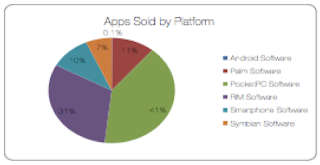 World market leader Nokia had a bruising 2008, at least in the smartphone field. According to a study, the Finns’ market share in this segment dropped by 10% to a – well – still fairly respectable 40.8% in Q4/2008 (as compared to 50.9% a for the quarter in the previous year). Painful!
World market leader Nokia had a bruising 2008, at least in the smartphone field. According to a study, the Finns’ market share in this segment dropped by 10% to a – well – still fairly respectable 40.8% in Q4/2008 (as compared to 50.9% a for the quarter in the previous year). Painful!
Worldwide: Smartphone Sales to End Users by Vendor
(Thousands of Units)
| Company | 4Q08 Sales | Market Share4Q08 (%) | 4Q07 Sales | Market Share4Q07 (%) | 4Q07-4Q08 Growth (%) |
|---|---|---|---|---|---|
| Nokia | 15,561.7 | 40.8% | 18,703.3 | 50.9% | -16.8% |
| RIM | 7,442.6 | 19.5% | 4,024.7 | 10.9% | 84.9% |
| Apple | 4,079.4 | 10.7% | 1,928.3 | 5.2% | 111.6% |
| HTC | 1,631.7 | 4.3% | 1,361.1 | 3.7% | 19.9% |
| Samsung | 1,598.2 | 4.2% | 671.5 | 1.8% | 138.0% |
| Others | 7,829.7 | 20.5% | 10,077.3 | 27.4% | -22.3% |
| Total | 38,143.3 | 100% | 36,766.1 | 100% | 3.7% |
Worldwide: Smartphone Sales to End Users by Vendor, 2008
| Company | 2008 Sales | Market Share 2008 | 2007 Sales | Market Share 2007 | Growth 2007-2008 |
|---|---|---|---|---|---|
| Nokia | 60,920.5 | 43.7% | 60,465.0 | 49.4% | 0.8% |
| RIM | 23,149.0 | 16.6% | 11,767.7 | 9.6% | 96.7% |
| Apple | 11,417.5 | 8.2% | 3,302.6 | 2.7% | 245.7% |
| HTC | 5,895.4 | 4.2% | 3,718.5 | 3.0% | 58.5% |
| Sharp | 5,234.2 | 3.8% | 6,885.3 | 5.6% | -24.0% |
| Others | 32,671.4 | 23.5% | 36,176.6 | 29.6% | -9.7% |
| Total | 139,287.9 | 100% | 122,315.6 | 100% | 13.9% |
Worldwide: Smartphone Sales to End Users by Operating System, 4Q08
| Company | 4Q08 Sales | Market Share 4Q08 | 4Q07 Sales | Market Share 4Q07 | Growth 4Q07-4Q08 |
|---|---|---|---|---|---|
| Symbian | 17,949.1 | 47.1% | 22,902.5 | 62.3% | -21.6% |
| RIM | 7,442.6 | 19.5% | 4,024.7 | 10.9% | 84.9% |
| Windows Mobile | 4,713.9 | 12.4% | 4,374.4 | 11.9% | 7.8% |
| Mac OS X | 4,079.4 | 10.7% | 1,928.3 | 5.2% | 111.6% |
| Linux | 3,194.9 | 8.4% | 2,675.9 | 7.3% | 19.4% |
| Palm OS | 326.5 | 0.9% | 449.1 | 1.2% | -27.3% |
| Other OSs | 436.9 | 1.1% | 411.3 | 1.1% | 6.2% |
| Total | 38,143.3 | 100% | 36,766.1 | 100% | 3.7% |
Note: The “Other OSs” category includes sales of Sharp Sidekick devices based on the Danger platform.
Worldwide: Smartphone Sales to End Users by Operating System, 2008
| Company | 2008 Sales | Market Share 2008 | 2007 Sales | Market Share 2007 | Growth 2007-2008 |
|---|---|---|---|---|---|
| Symbian | 72,933.5 | 52.4% | 77,684.0 | 63.5% | -6.1% |
| RIM | 23,149.0 | 16.6% | 11,767.7 | 9.6% | 96.7% |
| Windows Mobile | 16,498.1 | 11.8% | 14,698.0 | 12.0% | 12.2% |
| Mac OS X | 11,417.5 | 8.2% | 3,302.6 | 2.7% | 245.7% |
| Linux | 11,262.9 | 8.1% | 11,756.7 | 9.6% | -4.2% |
| Palm OS | 2,507.2 | 1.8% | 1,762.7 | 1.4% | 42.2% |
| Other OSs | 1,519.7 | 1.1% | 1,344.0 | 1.1% | 13.1% |
| Total | 139,287.9 | 100% | 122,315.6 | 100% | 13.9% |
Note: The “Other OSs” category includes sales of Sharp Sidekick devices based on the Danger platform.











